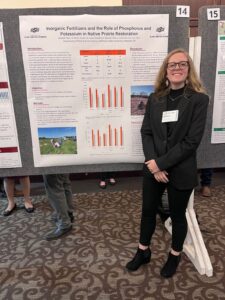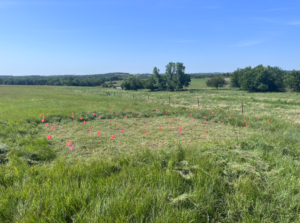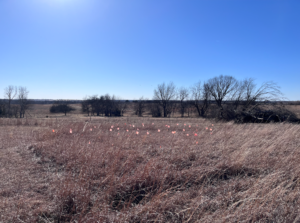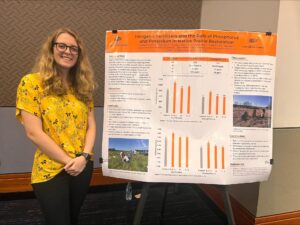Inorganic Fertilizers and the Role of Phosphorus and Potassium in Native Prairie Restoration
At Bamert Seed, we take immense pride in cultivating a love of the land that spans generations. We love to see the same thing happen to our team members. That’s why we are excited to share insights from a project conducted by Kendall Hays, the daughter of our Reclamation Specialist Brian Hays.

A student at Oklahoma State University, Kendall will graduate with degrees in Plant and Soil Science and Natural Resource Ecology and Management. This past year, she worked on a project in conjunction with OSU’s Department of Plant and Soil Science determining the role phosphorus and potassium play in developing and sustaining native prairie systems. The work in this project on the use of inorganic fertilizers in native prairie restoration provides valuable insights into enhancing soil fertility and prairie health.
Note: While the results here are very worthwhile, the emphasis is on smaller acreages, given the expense of implementing these methods on larger sections of land.
The Genesis of the Project

The project, developed under the guidance of Dr. Brian Arnall at Oklahoma State University, focuses on prairie fertility and its response to inorganic fertilizers specifically the impact of potassium and phosphorus compared to nitrogen as the sole nutrient. Many studies have been conducted on prairie fertility but focus on nitrogen as the driver of plant biomass rather than the restoration potential when added with other nutrients. The study was conducted on “go-back land,” previously utilized for cotton and wheat farming, which over the years had depleted essential nutrients such as nitrogen, phosphorus, and potassium.
A Team Approach

While we’re incredibly proud of Kendall, it’s important to acknowledge the team of people from Oklahoma State University who made this project a reality. Dr. Arnall and Dr. Laura Goodman provided guidance, support, and insight, as well as connections to Mike Major, the senior manager of the land used for this project.
Kendall was joined by graduate students Raedan Sharry, Jolee Derrick, and Sam Akin, as well as many hourly workers from Precision Nutrient Management Lab.
Study Design and Implementation
 This study involved carefully planned experiments on two different plots within less than a mile of each other—one a hay meadow and the other a grazing pasture. Both areas had been restored to native vegetation and presented great opportunities to observe how different land uses impact soil and plant health. The experiments tested various combinations of N, P, and K in the form of urea, triple super phosphate, and potash on these lands, providing a controlled and detailed analysis of how these fertilizers can influence soil nutrient levels and plant growth.
This study involved carefully planned experiments on two different plots within less than a mile of each other—one a hay meadow and the other a grazing pasture. Both areas had been restored to native vegetation and presented great opportunities to observe how different land uses impact soil and plant health. The experiments tested various combinations of N, P, and K in the form of urea, triple super phosphate, and potash on these lands, providing a controlled and detailed analysis of how these fertilizers can influence soil nutrient levels and plant growth.
To ensure precision, the trial area was divided into sections, further split into four replications with six plots each. Using dry granular forms of each fertilizer the treatments applied were: Control, P, K, NPK, N, and PK.
To simulate random dispersion, the team adopted a “feeding chickens” method of fertilizer application, mimicking a more organic spread that avoided concentration in any single area. Each treatment was documented through biomass harvest to gauge its effects on soil quality and plant health, setting a framework for assessing the effectiveness of the applied inorganic fertilizers.
Key Findings and Implications
 The findings highlighted significant enhancements in soil nutrient content and plant biomass when inorganic fertilizers were applied. Notably, the combination of nitrogen, phosphorus, and potassium (NPK) demonstrated the most substantial impact, promoting healthier, more robust plant growth which is crucial for effective prairie restoration, fertility, and production. These results suggest that precise applications of inorganic fertilizers can substantially accelerate the recovery of degraded lands, making them viable for sustainable agricultural and environmental conservation efforts sooner.
The findings highlighted significant enhancements in soil nutrient content and plant biomass when inorganic fertilizers were applied. Notably, the combination of nitrogen, phosphorus, and potassium (NPK) demonstrated the most substantial impact, promoting healthier, more robust plant growth which is crucial for effective prairie restoration, fertility, and production. These results suggest that precise applications of inorganic fertilizers can substantially accelerate the recovery of degraded lands, making them viable for sustainable agricultural and environmental conservation efforts sooner.
Practical Applications for Land Managers
For project managers and landowners, these insights are invaluable. They indicate that strategic fertilizer application can be a powerful tool in land reclamation and restoration projects, especially in areas where soil degradation is profound. Choosing the right type of fertilizer involves understanding the specific deficiencies of your soil and the types of plants you wish to support. Before any application of amendments soil tests should be performed to understand what problems the soil might have. For instance, areas low in phosphorus would benefit from applications of triple super phosphate, whereas nitrogen-rich urea could boost overall biomass in nutrient-poor soils.
 Further studying of these plots could help landowners make informed decisions based on their specific soil needs and long-term land management goals. With the insights gained here, land managers can enhance the ecological value of their lands, improving both the quantity and quality of native prairies.
Further studying of these plots could help landowners make informed decisions based on their specific soil needs and long-term land management goals. With the insights gained here, land managers can enhance the ecological value of their lands, improving both the quantity and quality of native prairies.
For small acreage owners, the takeaway from this study is clear: tailored soil management practices can lead to more productive and sustainable land use.
Future Study

Kendall presented her project this spring at Texas Tech at a soil fertility conference, and then earlier this month at a conference in Tennessee. After graduating from OSU, she will pursue her master’s at Sul Russ University, studying oil pad restoration and soil nutrients. Meanwhile, OSU will continue studying the land designated for this study to record outcomes and insights.
Photo Credit: Kendall Hays, Oklahoma State University



